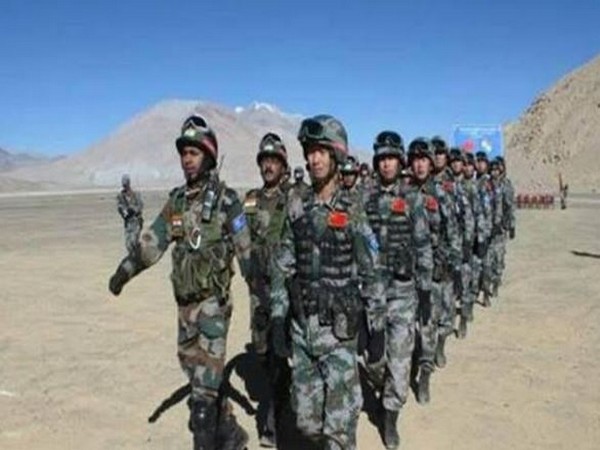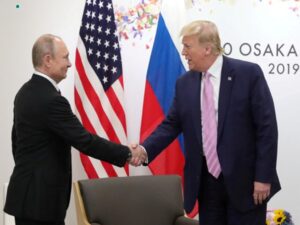
By Krishan Varma
New Delhi [India], July 14 (ANI): China‘s brazen attempts at annexing territories from its neigbouring countries has been widely covered in the media. It has challenged Japan in the East China Sea, grabbed territory in the South China Sea, laid claims to Indonesian islands 1500 kms away and encroached upon territory not hitherto under its control in eastern Ladakh. It has repeatedly threatened Taiwan with invasion, throttled democratic rights in Hong Kong SAR, and threatened Australia with economic retribution and cyber attacks.
For the first time, the Quad, in a concrete show of solidarity, reacted with alacrity to the Dragon’s unethical and premeditated expansionist agenda. The US dispatched two modern aircraft carrier battle groups to the SCS area. It agreed to supply more sophisticated weapons and equipment to Taiwan. Meanwhile, a comprehensive Pacific Deterrence Initiative is being formulated. In continuation of the reciprocal trade war, the US raised the stakes for the Chinese by taking effective steps at ‘de-coupling’ in sensitive technological areas: they shut out transfer and sale of cutting edge technology and hi-tech equipment to Chinese telecommunication behemoths. It expressed solidarity with India‘s ban on Chinese digital applications and steps to block Huawei and ZTE from the Indian market.
Similarly, Japan showed seriousness in reducing dependency on Chinese manufactured goods and services. It demonstrated firm determination to shift manufacturing facilities out of China that will have a salutary effect on the anticipated huge economic losses to China such a move entails. The possibility of Japan and India signing a Logistics Support Agreement on lines similar to the ones signed with the US and Australia must have been noted with wariness in the Chinese defence establishment.
The Australian government allocated an increase in defence spending to the tune of Australian $270 billion to develop a robust counter to Chinese moves in the region. Confirmation about participation of the Australian naval ships in the Malabar naval exercises with India next year will be symbolic of the growing confluence of maritime interests in the littoral states in the Indo Pacific region, and exert further pressure on China.
In tandem with India‘s banning of Chinese digital apps and with other countries in the Indo-Pacific region and EU joining in solidarity, sustained blocking of Chinese digital business in advanced countries is obviously hurting the Chinese economy and technological advancement.
These pain points worth billions of US dollars in monetary terms and the politico-socio-economic leverages it brings along with it have apparently resulted in a dramatic change in tone and tenor of Chinese “wolf warrior diplomats”. China has changed gears to persuade the Japanese to stay in China, offering them new inducements. An article in the Global Times on July 9 by Chinese Foreign Minister Wang Yi revealed a marked dilution in China‘s recent shrill anti-US rhetoric by stating that “China-US relations were facing their most serious challenge since the establishment of diplomatic ties” and that China was not seeking confrontation with the US but only desired the two sides to coexist. The Chinese Ambassador to India, Sun Weidong referred to India and China as “partners, rather than rivals” against the tough Indian response to Chinese transgressions into areas hitherto not under their control and beyond in some key areas in the Galwan River Valley and Pangong Tso. This came in the backdrop of the partial disengagement by Indian and Chinese troops at key friction points in the Ladakh sector of the LAC.
India must not be lulled into any sense of complacency by the Chinese moves to “disengage and de-escalate” tensions in the border. It seems that they are merely recalibrating their tactics to prolong and hang on to some significant gains in territorial positions in the face of an unexpectedly firm response from the Indian Army and rapid coalition of countries on its land and sea borders. It is geo- strategically isolated. It cannot fight on two fronts, in the South China Sea and Ladakh at the same time and keep up their military pressure on Taiwan and repression in Hong Kong SAR.
Clearly, more needs to be done with long-term strategy in focus for the Chinese regime to fully realize the cost of such misadventures in future.
Among other options, one of the most effective is increased coordinated action within the Quad and its expansion to a Quad Plus configuration (Ref my article in The Sunday Guardian on May 8, 2020-perhaps the first reference to such a grouping). India can take the lead in extending the Andaman and Nicobar tri services theatre command as the intelligence and limited operational hub for its members in the Indian Ocean. Besides, monitoring Chinese naval activity and checking attempts to gain sea access to the Indian Ocean via the Bay of Bengal through Sittwe port in Myanmar and Chittagong in Bangladesh, if this can materialize, the propensity of the Quad Plus – which includes India and envisages inclusion of Taiwan, Vietnam, Indonesia and perhaps South Korea and New Zealand – to act in unison and choke the Malacca Strait grows exponentially. Such a move can additionally broaden the theatre of counter operations against a belligerent China by opening a naval front that can potentially cripple the Chinese economy. More than 80 % of its energy imports and 64% of its maritime trade flows through this narrow strait.
Such a carefully calibrated reprisal short of war as part of India‘s Act East policy can add significantly to the confidence of ASEAN countries looking at a balance of power in their region against the chauvinism and hegemonic Chinese influence. More importantly, such a pushback can contribute to the growing internal political, economic and ethnic pressures that can deservedly cost Xi Jinping his ‘China Dream’. If China cannot produce enough with energy resources stifled and exports flagging, the consequent turmoil in the Chinese domestic arena will be very difficult to control. These adversities can galvanize the underlying voices of dissent and restiveness in the Chinese polity, and challenge the Xi leadership. It will also be a lesson to the Chinese leadership on the need to conform to the rule based international order and honour treaties, agreements and protocols, and deter expansionist misadventures.
For India, the abovementioned scenario offers the unique opportunity for the self-defence of its territorial and national sovereignty, with limited external involvement like intelligence sharing, receiving timely supply of weapons, equipment and ammunition from its diversified suppliers and expanding its share in the global supply chain. India has to unflinchingly continue with its current revised policy towards economic and trade engagement with China despite predictable efforts by the Chinese to mollify it through it carefully cultivated multiple levers of influence in the Indian polity. It must sustain the moves and bear the “pain” of higher prices and self – reliance that will be only temporary, given India‘s resilience when sacrifices have to be made.
Domestically, India should begin by reappraising its Tibet policy. It should redevelop the ‘Tibet Card’ that has the real potential of causing major turbulence in China‘s underbelly. It must shed its ambivalence and address the following questions: In close concert with the Central Tibetan Administration, the unofficial “Tibetan government in exile”, and with the blessings of the Dalai Lama and support of the Tibetan diaspora, should it not press the claim of the entire Ladakh region as a part of India? Should it not re-initiate discussion on its claims on Menser, located at the foothills of Mt Kailash, about which local records suggest that the then J&K authorities collected annual revenues up to 1965? At a much larger scale, should India not encourage a debate to review recognition of TAR as part of China? Should it not accord a conspicuous profile to the Tibetan religious leadership based in India? Should it not align its policy on the issue with the US and support the ‘Tibet Policy and Support Act (2019)’ that has been passed by the US Congress and is pending US Senate approval before being promulgated into law through due process. After all, if China pays scant regard for treaties, agreements and protocols and insists in ignoring India‘s core concerns, should India not follow reciprocity?
Should India not reassess its stand on the obvious expansionist attempt by China to extend the borders of present Xinjiang by laying claim to the Galwan region and stealthily gain territory in Gilgit- Baltistan and POK areas of the J&K and Ladakh regions through the China–Pakistan Economic Corridor project. Should India not raise China‘s repression of Uighurs and their plight in international forums in the same way as China does to the so-called plight of Kashmiris in the valley? The Chinese harbor Indian insurgents and give sanctuary to them in their territory. Should India not give similar access for Uighur activists to, at least, visit India?
At this time, India could highlight the plight of HK citizens and the brutal repression of democratic rights of the citizens of Hong Kong with China reneging on the Sino-British Joint Declaration in 1984, which guaranteed the preservation of the democratic character of HKSAR for 50 years after the 1997 handover. India has a right and duty to protect the rights of the professional and prosperous Indian community there.
We could also build our relationship with Taiwan in a more substantive and meaningful way. Other than supporting its membership in international organizations and attracting more high-grade technology and investments, can a bilateral “free trade agreement” be considered? Within the Quad structure, can the US be persuaded to re-evaluate the “sell out” US-China Third Communique signed in 1982 and give teeth to its Six Assurances to Taiwan? Can assurances to adhere to the ‘One China‘ principle be revisited in some effective manner in the radically changed circumstances, before the US Presidential elections?
It is certainly not the time to fall victim again to the Chinese charm offensive, but to have a firm resolve, be resolute and determined to safeguard our sovereignty and territorial integrity against Chinese expansionism in conjunction with its lackey, Pakistan. The next 3-4 months is critical for India‘s leadership and diplomacy to do its utmost to build strategic alignments with like-minded nations to reinforce the uncompromising convergence of interest to halt and roll back China from its illegally claimed territories. It must convincingly be discouraged and dis-incentivized to not pursue its naked ambition to aggrandize territory and threaten smaller nations with subjugation and economic plunder.
The time seems to be right for the Chinese leadership to experience the blowback to the “coercive diplomacy’ that it so brazenly practices, and drive home the point that it is not a globally approved year of the Dragon!
(The author of this Opinion article is Krishan Varma, former Special Secretary to the Government of India, Cabinet Secretariat.) (ANI)

















